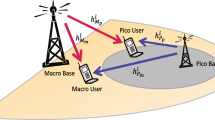Abstract
On the two-user multiple-input multiple-output (MIMO) broadcast channel, when one user with low mobility (called the static user) knows the exact channel state information (CSI) whereas the other user with high mobility (called the dynamic user) does not know CSI, a novel multiplicative superposition signaling scheme could obtain additive degree of freedom. Based on this novel signaling scheme, different types of receivers over an two-Heterogeneous-Speed-User MIMO broadcast channel are investigated in this study. At the dynamic user, the non-coherent maximum likelihood detection (NCMLD) is used. At the static user, we propose two hard detection scheme based on NCMLD-ML and NCMLD-Minimum-Mean-Square-Error (MMSE), respectively. We derive the union bound of the symbol error rate for the optimal hard detection scheme and the upper bound of that for the MMSE-based hard detection scheme. To avoid the error-propagation problem in the hard detection schemes, we also propose a low-complexity soft detection scheme based on the conditional expectation and MMSE (CE-MMSE). Simulation results show that the NCMLD-ML scheme outperforms the NCMLD-MMSE scheme and CE-MMSE scheme. Furthermore, CE-MMSE scheme has a better error performance than NCMLD-MMSE in the low signal-to-noise ratio region at the expense of higher complexity which is inconsiderable when compared with NCMLD-ML scheme. The numerical and simulation results verify the correctness of the theoretical analysis.







Similar content being viewed by others
References
ITU-R SG5/60. (2008). Draft New Report ITU-R M: Requirements related to technical system performance for IMT-advanced radio interface(s).
IMT-2020(5G)PG. (2014). White paper on 5G vision and requirements.
Li, Y., & Nosratinia, A. (2012). Product superposition for MIMO broadcast channels. Information Theory, IEEE Transactions on, 58(11), 6839–6852.
Li, Y., & Nosratinia, A. (2013). Pilot-based product superposition for downlink multiuser MIMO. In Information theory proceedings (ISIT), 2013 IEEE international symposium on (pp. 614–618).
Li, Y., & Nosratinia, A. (2015). Coherent product superposition for downlink multiuser MIMO. Wireless Communications, IEEE Transactions on, 14(3), 1746–1754.
Hochwald, B. M., & Marzetta, T. L. (2000). Unitary space-time modulation for multiple-antenna communications in Rayleigh flat fading. Information Theory, IEEE Transactions on, 46(2), 543–564.
Hochwald, B. M., Marzetta, T. L., & Hassibi, B. (2001). Space-time autocoding. Information Theory, IEEE Transactions on, 47(7), 2761–2781.
Milton, J. S., & Arnold, J. C. (2002). Introduction to probability and statistics: Principles and applications for engineering and the computing sciences. New York: McGraw-Hill Inc.
Gomadam, K. S., & Jafar, S. A. (2007). Optimal relay functionality for SNR maximization in memoryless relay networks. Selected Areas in Communications, IEEE Journal on, 25(2), 390–401.
Zhang, D., Liu, J., Xu, H., & Ji, H. (2010). Pair-wise error probability and its Chernoff upper bound for unitary space-time code. Science China Information Sciences, 53(8), 1613–1621.
Zhu, X., & Murch, R. D. (2002). Performance analysis of maximum likelihood detection in a MIMO antenna system. Communications, IEEE Transactions on, 50(2), 187–191.
Craig, J. W. (1991). A new, simple and exact result for calculating the probability of error for two-dimensional signal constellations. In Military communications conference, 1991. MILCOM’91, conference record, military communications in a changing world., IEEE (pp. 571–575).
Simon, M. K., & Alouini, M. S. (2005). Digital communication over fading channels (Vol. 95). New York: Wiley.
Kim, N., Lee, Y., & Park, H. (2008). Performance analysis of MIMO system with linear MMSE receiver. Wireless Communications, IEEE Transactions on, 7(11), 4474–4478.
Yu, C., & Hao, L. (2014). Multiplicative superposition signaling based detection schemes for heterogeneous-speed users. In Wireless vehicular communications (WiVeC), 2014 IEEE 6th international symposium on IEEE, (pp. 1–5).
Guo, Y., & You, X. (2011). Impact of channel correlation on performance of unitary space-time codes. Chinese Journal of Electronics, 20(3), 545–549.
Acknowledgments
This work was supported by National Basic Research Program of China (973 Program No. 2012CB316100), the NSFC project (No. 61271245) and the National Key Special Project (No.2011ZX03001-007-01).
Author information
Authors and Affiliations
Corresponding author
Rights and permissions
About this article
Cite this article
Yu, C., Hao, L. Receiver Design and Performance Analysis of Multiplicative Superposition Signaling Scheme for Heterogeneous-Speed Users. Wireless Pers Commun 84, 421–437 (2015). https://doi.org/10.1007/s11277-015-2615-8
Published:
Issue Date:
DOI: https://doi.org/10.1007/s11277-015-2615-8




